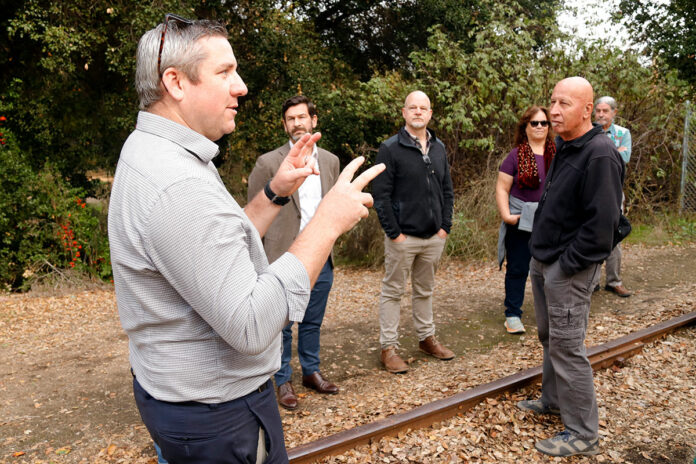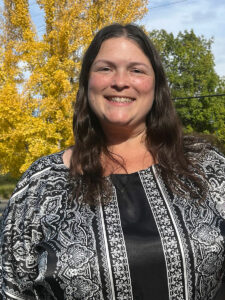
A dozen more-curious-than-normal hikers walked along Foss Creek Pathway on Thursday last week, taking the measure of the footpath from the City Hall at North and Grove streets south to the trail’s current terminus where the railroad tracks cross Front Street.
Though a public notice encouraged all comers to join the walk, most were directly or indirectly associated with the Great Redwood Trail, the proposed multi-use trail that will follow the old Northwest Pacific Railway line from Sonoma County north to Humboldt County, near the Oregon border.
At the end of the trail, the pathway met the old railroad bridge spanning the Russian River just upstream from the recently remodeled Healdsburg Memorial Bridge. Recent grants earned by SMART, the Sonoma Marin Area Rail Transit agency, have opened the door for the reconstruction of the railroad bridge and a pedestrian-bicycle path that will run parallel to it.
That construction job will bring SMART to Healdsburg, possibly as early as 2027. It will also add more than four miles of the pedestrian pathway SMART has designed to accompany the rail line. When the pathway connects with Healdsburg it will join the pre-existing 2.4 miles of the Foss Creek Pathway—a trail system that is still pushing northward, according to Zimmer.
When the in-city pathway is complete, it will run a total of 2.58 miles, at a total cost to the city of $6.5 million, half of that from Measure M transportation bonds. The coming connection with the SMART pathway will extend it south; by 2028, a northern section from Chiquita Road, near the Community Center where the path now ends, will extend it northward to the city limits past the in-development North Healdsburg complex.
Rail to Trail
While the Foss Creek Pathway is an excellent example of what the Great Redwood Trail Agency would like to create along the full length of the Great Redwood Trail, board members were realistic that a continuous 320-mile-long trail was unlikely in the near term.
Instead, other signature sections are existing examples of what the vision might become. These include the Ukiah Rail Trail, the Eureka Waterfront Trail, the Humboldt Bay Trail, Arcata’s Rail-with-Trail, and the Annie and Mary Trail from Arcata to Blue Lake.

“Historically the rail line ran from Blue Lake to Arcata, and Annie and Mary were the two station attendants that you had to buy a ticket from,” said Elaine Hogan, a former city council member in Blue Lake. “And so it’s named the Annie and Mary Trail locally in Blue Lake.”
Blue Lake is a small city a 10th the size of Healdsburg, with about 1,200 residents, located in a deep valley on the Mad River to the east of Arcata. It is projected as the northern end of the Great Redwood Trail.
“In Blue Lake, we have really taken an approach to economic development through developing our recreation opportunities,” said Hogan. “We really see the trail as being a key part of fostering economic development and new business development in the city and our recreation economy.”
In that, Blue Lake is typical of many communities along the former Northwestern Pacific Railway, even to some extent including Healdsburg, that have suffered with the decline of the lumber industry. It is these communities that have taken the lead in rail-to-trail projects.
“We do know that they support small-town economic development, especially in more rural areas,” said Hogan of rail-to-trail projects. “That is what we know, from elsewhere in the country and the study that’s been done on this Great Redwood Trail potential.”
A key order of business for the Nov. 9 meeting of the GRTA was the confirmation of Hogan as the agency’s new executive director.
“I’ve been following this project for several years now, through the rail banking process and the transition from the North Coast Railroad Authority to now the Great Redwood Trail Agency,” Hogan said as the board met in closed session to finalize her contract. “This is a project I’m passionate about, and I am looking forward to hopefully having the opportunity to lead the agency forward.”
Hogan, 36, currently works with Humboldt County. At the meeting, the board confirmed her contract, and she will begin work on Jan. 2, 2024.







